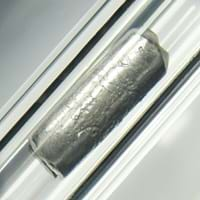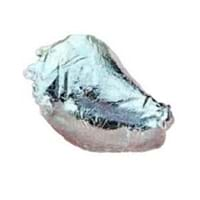Thallium vs Technetium
Periodic Table
Symbol
Tl
Tc
Group Number
13
5
7
11
Period Number
6
5
Block
p block
d block
Element Family
Post-Transition
Transition Metal
CAS Number
7440280
99+
7440268
99+
Space Group Name
P63/mmc
P63/mmc
Space Group Number
194.00
5
194.00
5
Facts
Interesting Facts
- Compounds of Thallium metal are highly Toxic.
- Thallium metal is being suspected as a human carcinogen.
- Original name of Technetium was Masurium.
- At the time of its discovery it found in sample of Molybdenum.
Sources
Found As a By-product, Ores of metals, Ores of Minerals
Made by Bombarding Molybdenum with Deuterons
History
Who Discovered
William Crookes
Emilio Segrè and Carlo Perriero
Discovery
In 1861
In 1937
Abundance
Abundance In Universe
5 * 10-9 %
32
Not Available
Abundance In Sun
~0.0000001 %
26
~-9999 %
Abundance In Meteorites
0.00 %
99+
Not Available
Abundance In Earth's Crust
0.00 %
99+
Not Available
Abundance In Oceans
0.00 %
34
Not Available
Uses
Uses & Benefits
- Thallium is a toxic metal and hence it has limited uses. Thallium metal is mostly used for producing photoelectric cells.
- In thermometer’s mercury alloy has 8% of thallium, as it has a melting point lower than 20°C.
- Technetium is a radioactive metal and hence it is used for medical studies and other research purposes.
Industrial Uses
Chemical Industry
NA
Medical Uses
Medical Research
NA
Other Uses
Alloys
Alloys, Nuclear Research, Research Purposes
Biological Properties
Toxicity
Highly Toxic
Low Toxic
Present in Human Body
Yes
No
In Blood
0.00 Blood/mg dm-3
34
0.00 Blood/mg dm-3
37
In Bone
0.00 p.p.m.
33
0.00 p.p.m.
36
Physical Properties
Melting Point
303.50 °C
99+
2,200.00 °C
9
Boiling Point
1,457.00 °C
99+
4,877.00 °C
7
Appearance
Physical State
Solid
Solid
Color
Silvery White
Shiny Gray
Luster
NA
NA
Hardness
Mohs Hardness
1.20
20
Not Available
Brinell Hardness
26.50 MPa
99+
Not Available
Speed of Sound
818.00 m/s
99+
16,200.00 m/s
1
Optical Properties
Allotropes
No
No
α Allotropes
Not Available
Not Available
β Allotropes
Not Available
Not Available
γ Allotropes
Not Available
Not Available
Chemical Properties
Chemical Formula
Tl
Tc
Isotopes
Known Isotopes
32
7
18
21
Electronegativity
Pauling Electronegativity
1.62
21
1.90
11
Sanderson Electronegativity
2.25
5
Not Available
Allred Rochow Electronegativity
1.44
17
1.36
20
Mulliken-Jaffe Electronegativity
1.96
6
Not Available
Allen Electronegativity
1.79
13
1.51
28
Electropositivity
Pauling Electropositivity
2.38
33
2.10
99+
Ionization Energies
1st Energy Level
589.40 kJ/mol
99+
702.00 kJ/mol
36
2nd Energy Level
1,971.00 kJ/mol
14
1,470.00 kJ/mol
99+
3rd Energy Level
2,878.00 kJ/mol
32
2,850.00 kJ/mol
33
Electrochemical Equivalent
7.63 g/amp-hr
2
0.52 g/amp-hr
99+
Electron Work Function
3.84 eV
28
Not Available
Other Chemical Properties
Corrosion, Ionization, Radioactive Isotopes, Solubility
Anti Corrosion, Ionization, Radioactive Isotopes, Radioactivity, Solubility
Atomic Properties
Atomic Number
81
35
43
99+
Electron Configuration
[Xe] 4f14 5d10 6s2 6p1
[Kr] 4d5 5s2
Crystal Structure
Hexagonal Close Packed (HCP)
Hexagonal Close Packed (HCP)
Crystal Lattice
BCC-Crystal-Structure-.jpg#100
HCP-Crystal-Structure-of-Technetium.jpg#100
Atom
Number of Protons
81
35
43
99+
Number of Neutrons
123
20
55
99+
Number of Electrons
81
35
43
99+
Radius of an Atom
Atomic Radius
170.00 pm
22
136.00 pm
99+
Covalent Radius
145.00 pm
39
147.00 pm
37
Van der Waals Radius
196.00 pm
30
200.00 pm
28
Atomic Weight
204.38 amu
31
98.00 amu
99+
Atomic Volume
17.20 cm3/mol
31
8.50 cm3/mol
99+
Adjacent Atomic Numbers
Valence Electron Potential
9.60 (-eV)
99+
180.00 (-eV)
3
Lattice Constant
345.66 pm
99+
273.50 pm
99+
Lattice Angles
π/2, π/2, 2 π/3
π/2, π/2, 2 π/3
Lattice C/A Ratio
1.60
6
1.60
5
Mechanical Properties
Density
Density At Room Temperature
11.85 g/cm3
31
11.00 g/cm3
34
Density When Liquid (at m.p.)
11.22 g/cm3
13
Not Available
Tensile Strength
Not Available
Not Available
Viscosity
Not Available
Not Available
Vapor Pressure
Vapor Pressure at 1000 K
16.90 (Pa)
5
Not Available
Elasticity properties
Shear Modulus
2.80 GPa
99+
Not Available
Bulk Modulus
43.00 GPa
28
Not Available
Young's Modulus
8.00 GPa
99+
Not Available
Poisson Ratio
0.45
2
Not Available
Other Mechanical Properties
Ductile, Sectile
NA
Magnetic Properties
Magnetic Characteristics
Specific Gravity
11.85
22
11.50
24
Magnetic Ordering
Diamagnetic
Paramagnetic
Electrical Properties
Electrical Property
Conductor
Conductor
Resistivity
0.18 nΩ·m
99+
200.00 nΩ·m
18
Electrical Conductivity
0.06 106/cm Ω
32
0.07 106/cm Ω
30
Electron Affinity
19.20 kJ/mol
32
53.00 kJ/mol
18
Thermal Properties
Specific Heat
0.13 J/(kg K)
39
0.21 J/(kg K)
29
Molar Heat Capacity
26.32 J/mol·K
29
24.27 J/mol·K
99+
Thermal Conductivity
46.10 W/m·K
33
50.60 W/m·K
30
Critical Temperature
Not Available
Not Available
Thermal Expansion
29.90 µm/(m·K)
12
7.10 µm/(m·K)
99+
Enthalpy
Enthalpy of Vaporization
162.10 kJ/mol
99+
660.00 kJ/mol
6
Enthalpy of Fusion
4.27 kJ/mol
99+
23.01 kJ/mol
9
Enthalpy of Atomization
179.90 kJ/mol
99+
649.00 kJ/mol
8
Standard Molar Entropy
64.20 J/mol.K
19
181.10 J/mol.K
2
|
||
|
||
|












